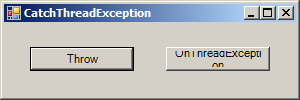
Imports System.Drawing
Imports System.IO
Imports System.Windows.Forms
Imports System.Math
public class ApplicationLevelException
public Shared Sub Main
Application.Run(New Form1)
End Sub
End class
Public Class Form1
' Install the ThreadException event handler.
Private Sub Form1_Load(ByVal sender As Object, ByVal e As System.EventArgs) Handles Me.Load
AddHandler Application.ThreadException, AddressOf Me.app_ThreadException
End Sub
' Catch a ThreadException event.
Private Sub app_ThreadException(ByVal sender As Object, ByVal e As System.Threading.ThreadExceptionEventArgs)
MessageBox.Show("Caught unhandled exception")
End Sub
' Throw an InvalidDataException.
Private Sub btnThrow_Click(ByVal sender As System.Object, ByVal e As System.EventArgs) Handles btnThrow.Click
Throw New InvalidDataException("Bad data! Bad!")
End Sub
' Call the OnThreadException method.
Private Sub btnOnThreadException_Click(ByVal sender As System.Object, ByVal e As System.EventArgs) Handles btnOnThreadException.Click
Application.OnThreadException(New InvalidDataException("Bad data! Bad!"))
End Sub
End Class
<Global.Microsoft.VisualBasic.CompilerServices.DesignerGenerated()> _
Partial Public Class Form1
Inherits System.Windows.Forms.Form
'Form overrides dispose to clean up the component list.
<System.Diagnostics.DebuggerNonUserCode()> _
Protected Overloads Overrides Sub Dispose(ByVal disposing As Boolean)
If disposing AndAlso components IsNot Nothing Then
components.Dispose()
End If
MyBase.Dispose(disposing)
End Sub
'Required by the Windows Form Designer
Private components As System.ComponentModel.IContainer
'NOTE: The following procedure is required by the Windows Form Designer
'It can be modified using the Windows Form Designer.
'Do not modify it using the code editor.
<System.Diagnostics.DebuggerStepThrough()> _
Private Sub InitializeComponent()
Me.btnThrow = New System.Windows.Forms.Button
Me.btnOnThreadException = New System.Windows.Forms.Button
Me.SuspendLayout()
'
'btnThrow
'
Me.btnThrow.Location = New System.Drawing.Point(26, 24)
Me.btnThrow.Name = "btnThrow"
Me.btnThrow.Size = New System.Drawing.Size(104, 24)
Me.btnThrow.TabIndex = 2
Me.btnThrow.Text = "Throw"
'
'btnOnThreadException
'
Me.btnOnThreadException.Location = New System.Drawing.Point(162, 24)
Me.btnOnThreadException.Name = "btnOnThreadException"
Me.btnOnThreadException.Size = New System.Drawing.Size(104, 24)
Me.btnOnThreadException.TabIndex = 3
Me.btnOnThreadException.Text = "OnThreadException"
'
'Form1
'
Me.AutoScaleDimensions = New System.Drawing.SizeF(6.0!, 13.0!)
Me.AutoScaleMode = System.Windows.Forms.AutoScaleMode.Font
Me.ClientSize = New System.Drawing.Size(292, 73)
Me.Controls.Add(Me.btnThrow)
Me.Controls.Add(Me.btnOnThreadException)
Me.Name = "Form1"
Me.Text = "CatchThreadException"
Me.ResumeLayout(False)
End Sub
Friend WithEvents btnThrow As System.Windows.Forms.Button
Friend WithEvents btnOnThreadException As System.Windows.Forms.Button
End Class